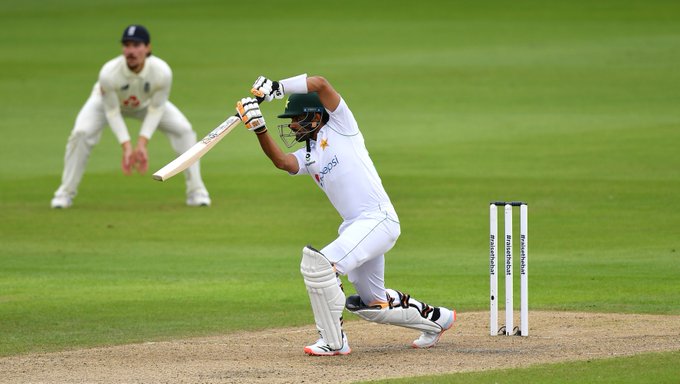Babar Azam isn’t a world-class batsman in Pakistan whites - at least not yet

Since his debut in 2016, Babar Azam has turned the whole world into his playing field with his limited-over form and success earning him plaudits from all corners of the world. But in red-ball cricket, there have been calls of expanding the fab four to fab five. So, does that make him world-class?
The question still remains, is the 25-year-old deserving of all the appreciation that has been coming his way from his 29-long Test matches? At 25, certainly, he is one of the brightest talents to have come out of the country, which has been often ruled or dominated by the influx of bowling talents. His average of 50 and 54 in ODI and T20I format has certainly boosted his stock and it has made the cricketing world sit up and take notice. Incidentally, that also coincided with his debut in the longest-format, where cricket fans were overawed by his performance, which boosted his Test form from just mere numbers to shots.
“Oh, what a beautiful cover drive from Babar Azam, surely Pakistan has unearthed a brilliant talent in the country filled with pacers,” has not been just a piece of commentary anymore. It's been over four years now and Azam has continued to showcase his batting form with a staggering average almost everywhere in the world. But with 1924 runs at an average of 44.74, should he be considered as a world-class batsman?
The Lahore batsman averages 44.74 but it has come at a bigger cost, five hundreds in nearly 50 innings with as many as 14 fifties. Scoring runs has never been the problem for the talented batsman as the numbers showcase that he is more than an able batsman in the Pakistani setup. At the same time, it also presents an incredible loophole, or an attribute that has been missing from his gameplay - converting fifties to hundreds, which is quintessential in red-ball cricket. Despite that, he has been compared heavily with India’s Virat Kohli, who has turned the world upside down with his run-scoring ability, resembling a run-machine.
Before the series, a lot of journalists from around the world started comparing the two batsmen from across the border. At the age of 25, his Indian counterpart had already set the world on fire despite having played just 22 Test matches, six short of the Pakistani batsman. However, it was not about just the centuries anymore as Kohli’s three centuries came under pressure when the rest of the team around him had folded. In 2012, against Australia, after the hosts put on 604 runs on board, the Indian batting lineup crumbled under pressure. There, Kohli was the only centurion, scoring 116 off 237 deliveries, leaving balls alone outside the off-stump while still attacking the bowlers.
Whilst his centuries against Australia and South Africa came away from home, his century against England came in tough conditions at home in Nagpur. From thereon, Kohli just absolutely dominated the proceedings, going on to average above the 50s every year, with 22 centuries in 36 innings, which roughly accounts to 61% conversion rate, putting him in the elite category, hands-down without debate.
So when the Karachi batsman was compared with Kohli, it surely should have raised several questions, whether the Pakistan man was worthy of being compared with the world’s best; being called an elite batsman. The answer should not be marred by his amazing stroke-making ability and his casual drives that opens and keeps jaws open. Rather, the answer should be a testament to his numbers in the longest-format. Three of his five centuries thus far have come in home conditions against Sri Lanka and Bangladesh. Whilst Bangladesh were clearly clueless on how to tackle Pakistan in alien conditions, Sri Lanka did not offer anything substantially different to their Asian counterparts.
In such fashion, that is knacky, the Pakistani batsman had made himself look larger than life in Pakistan cricket. In the absence of such a talent in the batting department, it was rather easy to convince the fans that he was indeed a world-class batsman. At the Ageas Bowl, he had a genuine chance to quash any critics and criticism, after crossing the rough part of the ocean. He was on 47, having faced 127 deliveries out of which he had left 33% of the deliveries and scored just three boundaries. In comparison, at Old Trafford, the right-hander scored 69 runs, out of which 44 runs were from boundaries, which is a testament of what he does best, score runs at a brisk pace.
A man who is free-flowing in his run-making thus far had the opportunity to put out a statement here at the Ageas Bowl, that he deserves to be on the same page as Virat Kohli, with his patience-level and strong technique. Everyone, including the commentators, wanted him to succeed and put on a show but that is only as much a spectator can do to influence proceedings. He genuinely looked gut-above his standard batting display, and had an opportunity to leap bound into the elite category. The situation was pretty much there for the Karachi-man to put on a Kohli-like performance.
But yes, one delivery was all it took for Azam fish out an edge to the wicketkeeper, off Stuart Broad, which quashed his hopes. For the Pakistani batsman to reach there, it's still a work-in-progress. More than hits, there are missed opportunities. He can be pretty flawless in his batting technique and super impressive when he drives that ball on the off-side but his conversion rate and his absence in crunch situations leaves a lot to be desired. It is not enough for him to stare up the steps, he really must step up the stairs if he wants to be looked up to.




Comments
Sign up or log in to your account to leave comments and reactions
0 Comments